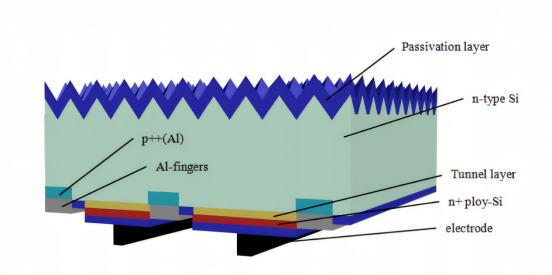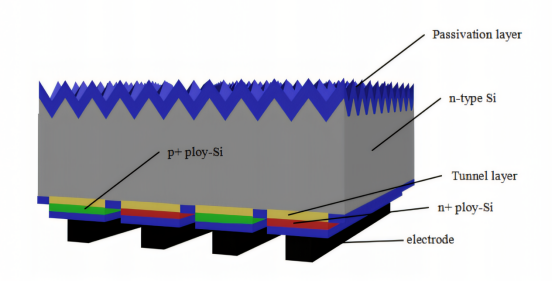
量子效率测试仪
PL/EL一体机
Sinton硅片少子寿命测试仪
Sinton硅块少子寿命测试仪
绒面反射率测试仪
3D共聚焦显微镜
清洗制绒工作站
在线四探针方阻测试仪
全自动扫描四探针方阻测试仪
在线薄膜厚度测试仪
晶化率测试仪
Horiba显微共焦拉曼光谱仪
傅里叶红外光谱仪
霍尔效应测试仪
分光光度计
全光谱椭偏仪
Horiba椭圆偏振光谱仪
TLM接触电阻率测试仪
超景深显微镜
网版智能影像测量仪
全自动影像测量仪
卧式拉力机
电池片稳态光衰老化试验箱
电池片紫外老化试验箱
电池片拉脱力综合测试仪
外观检验台
湿漏电测试系统
组件实验室EL测试仪
紫外老化试验箱
稳态光衰老化试验箱
电流连续性监测系统
PID测试系统
旁路二极管测试系统
LeTID测试系统
反向电流过载系统
脉冲电压测试系统
绝缘耐压测试仪
接地连续性测试仪
绝缘耐压接地测试仪
湿热环境试验箱
湿冻环境试验箱
热循环试验箱
动态机械载荷测试机
静态机械载荷测试机
冰雹冲击试验机
引出端强度试验机
霰弹冲击试验机
抗划伤(切割)测试机
剥离试验机
万能材料试验机(单臂)
万能材料试验机(双臂)
光伏玻璃透过率测试仪
醋酸测试试验箱
交联度测试系统
二极管接线盒综合测试仪
落球冲击试验机
半自动四探针
全自动探针式台阶仪
多通道太阳能MPPT系统
Horiba稳瞬态荧光光谱仪
钙钛矿P1激光划线测试仪
钙钛矿在线膜厚测试仪
钙钛矿工艺检测工作站
手持式IV测试仪
便携式EL测试仪
手持热成像测试仪
户外组件IV测试仪
户外组件多通道测试系统
光伏逆变器电能质量测试仪
无人机EL检测仪
高效太阳能电池:HPBC、TBC与HBC,三种不同BC电池结构对比
日期:2024-11-11浏览量:85
太阳能作为未来能源受到关注,在下一代产品的几种BC电池(HPBC、TBC、HBC)中,HPBC是太阳能电池技术发展的一个方向。HPBC电池结合了钝化发射极和背表面钝化接触技术(PERC)的优点,并采用了背接触设计。这种结构通常在电池的背面形成钝化接触,以减少正面的遮挡并提高光吸收。
三种不同BC电池的结构示意图

HPBC(Hybrid Passivated Back Contact)太阳能电池
HPBC电池,全称为复合钝化背接触电池(Hybrid Passivated Back Contact),是一种新一代的高效太阳能电池技术。
结构特点:HPBC电池结合了钝化发射极和背表面钝化接触(PERC)技术的优点,并采用了背接触设计,这种结构通常在电池的背面形成钝化接触,以减少正面的遮挡并提高光吸收。
钝化效果:HPBC电池的钝化层有助于减少表面复合,提高电池的开路电压(Voc)。技术特点:HPBC电池技术结合了TOPCon和IBC技术,将电池所有负责收集传输载流子的金属栅线全部移到组件背面,使得电池正面无栅线遮挡,从而提升光线利用率和光电转换效率。
技术优势:HPBC电池具有光线吸收更强、转换效率更高、电能传输更稳定、产品更美观、技术成熟更可靠等特点。
应用场景:HPBC电池天然适合分布式光伏场景,尤其是BIPV(光伏建筑一体化),可以充分结合BC组件的美观和建筑艺术。

TBC(TOPCon Back Contact)太阳能电池
TBC电池,全称为TOPCon与IBC技术结合形成的电池,也被称为POLO-IBC电池。
结构特点:TBC电池采用了隧道氧化层钝化接触(TOPCon)技术,并将其应用于背接触结构。这种设计利用了TOPCon技术的高钝化质量和良好的接触特性。效率潜力:TBC电池因其优异的钝化性能和背接触设计,具有较高的效率潜力。
产业化进度:目前,TBC电池技术路线均处于实验室研究阶段,产业化进程的推进仍有许多问题亟待解决。短期内TBC电池路线发展前景更广,因为TOPCon的工艺路线相比HJT的工艺路线更加成熟,成本更低,TBC产线又与TOPCon产线部分兼容。
应用潜力:TBC电池不仅能够应用于N型晶硅基底,也可以应用于P型基底,在光电转换效率提升和成本降低方面都有巨大潜力。

HBC(Heterojunction Back Contact)太阳能电池
HBC电池,即异质结背接触晶硅电池,是一种结合了异质结(HJT)技术和交叉指式背接触(IBC)技术的高效太阳能电池。
结构特点:HBC电池采用了异质结技术,并将其与背接触结构相结合。这种结构通常在电池的背面形成异质结,以实现高效的载流子收集。
高效率潜力:HBC电池因其优异的异质结特性和背接触设计,被认为是高效率太阳能电池的有力候选。
HPBC、TBC和HBC电池都代表了光伏电池技术的进步,它们通过不同的技术路径提高了电池的光电转换效率。
TBC和HBC电池在转换效率层面优于经典IBC技术。
HBC电池结合了HJT电池的表面钝化性能和IBC电池正面无金属遮挡的优点,具备大短路电流和高开路电压的双重优势,代表着晶硅太阳电池的最高光电转换效率水平。
美能QE量子效率测试仪
联系电话:400 008 6690
美能QE量子效率测试仪可以兼容测量所有太阳能电池的光谱响应,光谱范围从300nm-2500nm,可以测量EQE、IQE、反射率、透射率和短路电流密度等参数,搭配直径150mm积分球,为让您的光伏研究进展更加顺利。
n兼容所有太阳能电池类型,满足多种测试需求
n光谱范围可达300-2500nm,并提供特殊化定制
n氙灯+卤素灯双光源结构,保证光源稳定性
参考文献:Electrical Performance, Loss Analysis, and Efficiency Potential of Industrial-Type PERC, TOPCon, and SHJ Solar Cells: A Comparative Study




































































